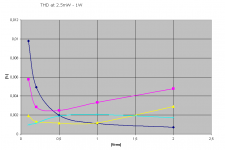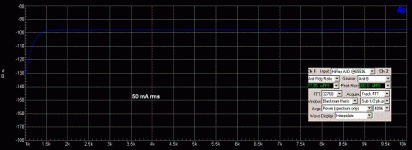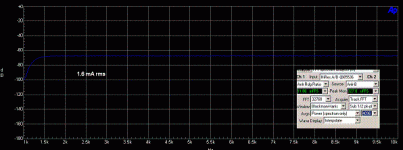john curl said:Scott, what does that have to do with it?
He didn't say after multiple trials he could tell them apart. He said he knew without listening what 1/2 LSB vs 1 LSB TPD dither @ 24bits would sound like. This is about the silliest thing I've read all day.
Charles, many years ago(1978), something similar happened to me.
I was in Nagoya, Japan at HK (Japan) facility, and they presented me with 3 different circuit topologies that I did not design, to listen to and compare. I picked up the differences in each circuit, and amazed the staff. It was what I do for a living. I didn't find it that special.
Many here just can't believe that these differences exist, or that we can hear them, in any case.
When we make our living at this, we often have found that we have the innate talent to hear differences and we have developed this skill over many years. We would have chosen another profession, if this were not so. I know what 'they' are up to. They have read Floyd Toole's book or some such and they are not going to believe us, even though we are famous for our designs. Oh well.
I was in Nagoya, Japan at HK (Japan) facility, and they presented me with 3 different circuit topologies that I did not design, to listen to and compare. I picked up the differences in each circuit, and amazed the staff. It was what I do for a living. I didn't find it that special.
Many here just can't believe that these differences exist, or that we can hear them, in any case.
When we make our living at this, we often have found that we have the innate talent to hear differences and we have developed this skill over many years. We would have chosen another profession, if this were not so. I know what 'they' are up to. They have read Floyd Toole's book or some such and they are not going to believe us, even though we are famous for our designs. Oh well.

Bobken said:On the other hand, the actual contact sides of these multi-contacts on mine do have rather more meat on them but this is only possible as they are spaced further apart, this being permitted by fewer contacts per switch.
They use several different sizes of contacts, depending on the number of switch positions, the size of the switch, whether it is MBB or BBM, and so on. The contact "blades" similarly vary in width.
Bobken said:What is more important in my view is the fact that whatever metal is used, there are so few junctions between input & outputs, no dissimilar metal *riveted* joins anywhere, and the quality (and mechanical engineering) of the entire assembly is so robust, with a short signal path, and using high quality metal of some kind of silver-alloy for the wiping contacts.
Yes, exactly. And that is something that I have never seen in any other switch from any other company. Plus they are very easy to deal with. They are glad to make custom variations -- at least so long as the quantities are reasonable. This is out of the question for a DIY hobbyist, but to order a few hundred custom switches is certainly no big obstacle for a specialist audio company. Not like when I asked Neutrik for a custom variation, and they reluctantly agreed to do a custom plating on a one-time basis if I ordered 50,000 parts....
scott wurcer said:He didn't say after multiple trials he could tell them apart. He said he knew without listening what 1/2 LSB vs 1 LSB TPD dither @ 24bits would sound like. This is about the silliest thing I've read all day.
Humor me for a moment Scott. Close your eyes and just imagine what you think rounding versus dither *might* sound like. I didn't say what the differences were -- let's see how close your guess is. Anyone else is welcome to also guess.
john curl said:Many here just can't believe that these differences exist, or that we can hear them, in any case.
When we make our living at this, we often have found that we have the innate talent to hear differences and we have developed this skill over many years.
Of course. Differences must exist, otherwise you wouldn't make a living.
syn08 said:
Of course. Differences must exist, otherwise you wouldn't make a living.
syn08, I have worked quite hard recently on collecting results of 4 very good amplifiers at low levels, they cover quite typical room listening levels. Do you think these amps would sound same?
Attachments
PMA said:
syn08, I have worked quite hard recently on collecting results of 4 very good amplifiers at low levels, they cover quite typical room listening levels. Do you think these amps would sound same?
Depends on the test.
DB, controlled test? No.
Sighted, informal test? But of course. That's what you do for a living
Jan Didden
Charles Hansen said:
Humor me for a moment Scott. Close your eyes and just imagine what you think rounding versus dither *might* sound like. I didn't say what the differences were -- let's see how close your guess is. Anyone else is welcome to also guess.
On components that probably have real performance of <20bits and where any effect is possibly an order of magnitude below the thermal noise I would have no basis to make a guess. I did say the two dither stratgies BTW.
janneman said:
Depends on the test.
DB, controlled test? No.
Sighted, informal test? But of course. That's what you do for a living
Jan Didden
Other way around.
I dunno, it must be nice to have one of those superhuman brains that is immune to conscious and unconscious biases, that doesn't need controls, that can't be fooled. They must not have fun at a magic show. Too bad, I love Penn and Teller.
Charles Hansen said:
In the end, it's not hard to tell what's going on if you have a careful listener that is intimately familiar with the system under test and the specific source material being played. I've found these last two items to be the most important items for conducting listening tests.
Cheers,
Charlie Hansen
Hi Charlie,
This is precisely what I have said on this Forum in the past, more than once before. I am also certain I have mentioned that under unfamiliar circumstances and/or with other equipment I would probably not be able to hear some of the lesser-obvious differences due to component changes, but this still does *not* indicate that any such minute changes don't exist.
I am simply unable to recognise them so readily.
It is attention to detail in every area, and with all of these often miniscule differences being optimised, which *cumulatively* give rise to the overall sonic improvements we strive for, and achieve.
Regards,
dimitri said:Jan,
NC - normally closed pair, 20mOhm, 50 mA - 1mV voltage drop across contacts, first graph - THD+N ref 1mV, second - ref 31.6uV
And 15uV thermoelectric potential.
dimitri said:Jan,
NC - normally closed pair, 20mOhm, 50 mA - 1mV voltage drop across contacts, first graph - THD+N ref 1mV, second - ref 31.6uV
Thanks, you had me worried there for a moment
I can live with -100dB re: 1mV.
Jan Didden
- Status
- Not open for further replies.
- Home
- Amplifiers
- Solid State
- John Curl's Blowtorch preamplifier



 ?
?